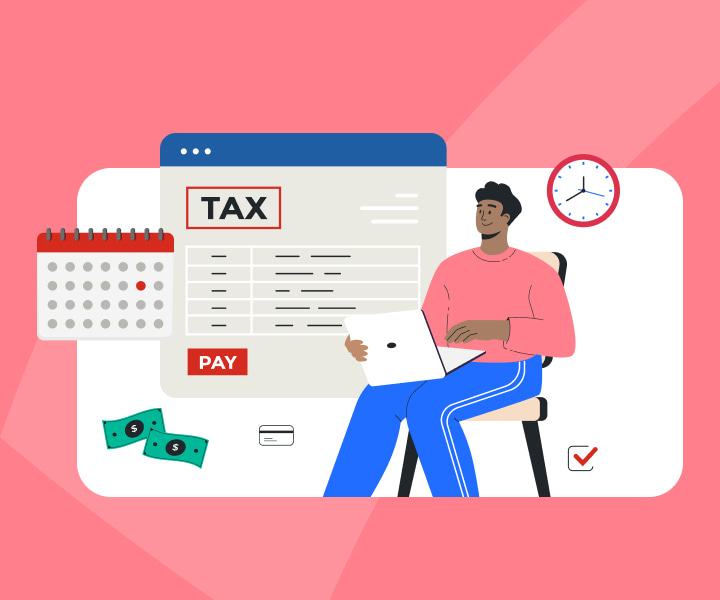Get all the expert help you need for only $20 when you’re 25 or younger with TurboTax
What Is Tax Refund Interest and How Does It Work?
TurboTax Canada
June 16, 2023 | 1 Min Read
Updated for tax year 2024

When you file your taxes every year, there are two important deadlines: the tax filing deadline and the date to pay any amounts you owe to the Canada Revenue Agency (CRA). Similarly, if you file your taxes on time and are supposed to receive a refund, the CRA says it will send you that money by a specific date. In either case, if payments are late, interest applies.
So how much interest will be charged, how is it calculated, and how does it affect you? Here, we break down the details on this aspect of your taxes.
Key Takeaways
- When the CRA owes you a tax refund, they must pay it to you by a specific deadline.
- If you don’t receive your tax refund by the deadline, the CRA will pay you interest on the refund amount.
- Tax refund interest is compounded daily based on the interest rates the CRA sets every quarter.
What is tax refund interest?
The CRA pays you tax refund interest when they send your tax refund later than they’re supposed to. (This isn’t a typo.)
The CRA doesn’t call it that, though. While “tax refund interest rate” is more user- friendly phrasing, the interest charged is officially called “overpaid remittance rate.” On the other hand, if you owe taxes, the interest rate charged on that amount is called the overdue remittance rate.
How does tax refund interest work?
When you file your taxes every year, you send the CRA a document, aka a tax return, that outlines your financial situation for the previous year as it pertains to income tax. This information includes your income, relevant deductions, credits, and expenses, and other factors affecting your personal income tax return, like where you live. It concludes with a calculation of how much income tax you owe for that tax year.
If you’ve already made income tax payments, then you also include that in the calculation. This usually happens when employers deduct tax from your paycheque and send it to the CRA on your behalf or if you make instalment payments (which is often the case if you’re self-employed or owe a balance of more than $3,000 to the CRA for three years in a row).
At that point, you find out one of three things:
- either the math works out to zero (technically $2 or less)
- you owe the CRA money
- they owe you—in other words, you get a tax refund. If you paid more in taxes than you needed to, that’s called an overpayment.
When the CRA receives your income tax submission, they assess it to check the numbers and ensure everything adds up. Then, you receive your notice of assessment, with the CRA’s calculation of who owes whom what.
If the CRA owes you a tax refund, they’re supposed to send it to you promptly by the deadlines they specify for each tax year. If that doesn’t happen, the CRA must start paying you interest on your tax refund. Hallelujah!
What is the tax refund interest rate?
Knowing what these rates are at any given time is a bit of a moving target. Every quarter (every three months), the CRA publishes its official interest rates for that period, called the prescribed interest rates.
These interest rates go up and down similarly to interest rates for mortgages and other kinds of loans. They are based on the yield on three-month Government of Canada treasury bills, which are a tool the federal government uses to borrow money.
Specific rates each quarter vary depending on factors including:
- Who is filing (a corporation or a non-corporate taxpayer)
- Who owes whom (rates on money owed to the CRA are higher than rates on money the CRA owes)
- The type of tax, duty, or other charge
For example, the CRA might set the interest rate on income tax overpayments for a specific quarter to five percent for corporations and seven percent for non-corporate taxpayers. So if you’re a Canadian and your tax refund is late, the CRA will pay you seven percent annual interest on that amount, compounded daily.
How is tax refund interest calculated?
Tax refund interest is calculated using an annual rate that is compounded daily. That means you add a percentage of the total amount each day. Each day the amount of money is slightly higher, so the interest charged based on that increasing total grows as time goes on. (Clearly a good scenario if you’re owed money; but not so much if you owe the CRA and are not able to pay on time.)
Interest is calculated starting on the latest payment deadline date specified by the CRA for the given tax year (aka roughly the end of May—if you file on time), the 30th day after you file your tax return (if you file late), or the day after you overpaid your taxes.
Daily compound interest example:
Say you filed your taxes, and the calculations show you overpaid $1,000. Assuming the CRA assessment agrees with those numbers, they owe you a $1,000 tax refund.
If they pay you this money on time, there’s no interest. But if the payment is late, they will pay you interest on top of the refund amount. Assume the payment is issued three days late, and the applicable interest rate is seven percent.
Remember that’s an annual interest rate, so you divide by 365 to get the daily interest rate of 0.07/365 (it has a lot of decimal points, so we rounded to the nearest penny).
Here’s how the math would go:
| Day | Principal | Daily interest | Total |
| 1 | $1,000 | $0.19 ($1,000 x 0.07/365) | $1,000.19 |
| 2 | $1,000.19 | $0.19 ($1,000.19 x 0.07/365) | $1,000.38 |
| 3 | $1,000.38 | $0.20 ($1,000.38 x 0.07/365) | $1,000.58 |
It doesn’t look like much in this example, but you can see how the interest could add up fast for larger sums of money and over longer periods of time.
Is refund interest taxable? Do I have to report it?
Yes, refund interest is taxable. You should report it on your tax return in line 12100 (Interest and Other Investment Income) in the year that you receive the interest income.
How much interest will I get on my tax refund?
Of course, how much interest you will get on your tax refund depends on how much you’re owed and how late the CRA is running.
To backtrack a sec: The agency aims to send people their tax refunds promptly—within two weeks for returns filed online and within eight weeks if you send in a paper return. Note that these time frames only apply when you file your taxes on time; if you’re late, it might take longer to get your refund.
The interest comes in if you don’t receive your tax refund by the CRA’s deadlines. This interest is compounded daily from the missed deadline until the date the CRA issues your refund, and it’s calculated based on the total refund due. So, as noted, the specific amount you will get depends on the amount of your tax refund and how many days late your payment is.
Take charge of your taxes
To make sure you get any refund you’re owed as quickly as possible, it pays to file your taxes on time and well. That’s where TurboTax comes in. Get advice and answers as you go, with a final tax expert review before you file.
Are you due a refund this year? Here are 7 smart ways to spend it.
File with confidence
Get advice and answers as you go, with a final tax expert review before you file.
Get StartedRelated articles

© 1997-2024 Intuit, Inc. All rights reserved. Intuit, QuickBooks, QB, TurboTax, Profile, and Mint are registered trademarks of Intuit Inc. Terms and conditions, features, support, pricing, and service options subject to change without notice.
Copyright © Intuit Canada ULC, 2024. All rights reserved.
The views expressed on this site are intended to provide generalized financial information designed to educate a broad segment of the public; it does not give personalized tax, investment, legal, or other business and professional advice. Before taking any action, you should always seek the assistance of a professional who knows your particular situation for advice on taxes, your investments, the law, or any other business and professional matters that affect you and/or your business.









